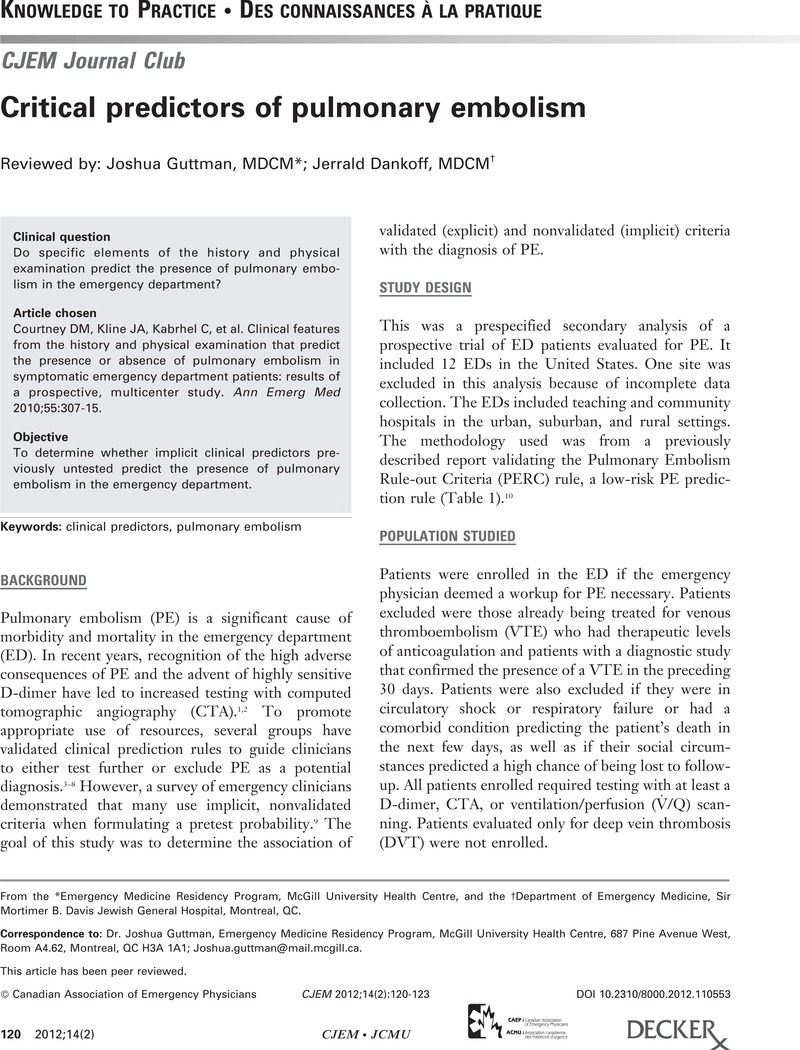No CrossRef data available.
Article contents
Critical predictors of pulmonary embolism
Published online by Cambridge University Press: 11 May 2015
Abstract
An abstract is not available for this content so a preview has been provided. As you have access to this content, a full PDF is available via the ‘Save PDF’ action button.

- Type
- Knowledge to Practice • Des connaissances à la pratique
- Information
- Copyright
- Copyright © Canadian Association of Emergency Physicians 2012
References
REFERENCES
1.Kabrhel, C, Matts, C, McNamara, C, et al. A highly sensitive ELISA D-dimer increases testing but not diagnosis of pulmonary embolism. Acad Emerg Med 2006;13:519–24, doi:10.1111/j.1553-2712.2006.tb01002.x.Google Scholar
2.Kline, JA, Courtney, DM, Beam, DM, et al. Incidence and predictors of repeated computed tomographic pulmonary angiography in emergency department patients. Ann Emerg Med 2009;54:41–8, doi:10.1016/j.annemergmed.2008.08.015.CrossRefGoogle ScholarPubMed
3.Wells, PS, Anderson, DR, Rodger, M, et al. Derivation of a simple clinical model to categorize patients’ probability of pulmonary embolism: increasing the models utility with the SimpliRED D-dimer. Thromb Haemost 2000;83:416–20.Google ScholarPubMed
4.Wicki, J, Perneger, TV, Junod, AF, et al. Assessing clinical probability of pulmonary embolism in the emergency ward: a simple score. Arch Intern Med 2001;161:92–7, doi:10.1001/archinte.161.1.92.CrossRefGoogle ScholarPubMed
5.Kline, JA, Nelson, RD, Jackson, RE, et al. Criteria for the safe use of D-dimer testing in emergency department patients with suspected pulmonary embolism: a multicenter US study. Ann Emerg Med 2002;39:144–52, doi:10.1067/mem.2002.121398.CrossRefGoogle ScholarPubMed
6.Kline, JA, Mitchell, AM, Kabrhel, C, et al. Clinical criteria to prevent unnecessary diagnostic testing in emergency department patients with suspected pulmonary embolism. J Thromb Haemost 2004;2:124755, doi:10.1111/j.1538-7836.2004.00790.x.CrossRefGoogle ScholarPubMed
7.Wells, PS, Anderson, DR, Rodger, M, et al. Excluding pulmonary embolism at the bedside without diagnostic imaging: management of patients with suspected pulmonary embolism presenting to the emergency department by using a simple clinical model and D-dimer. Ann Intern Med 2001;135:98–107.CrossRefGoogle Scholar
8.LeGal, G, Righini, M, Roy, PM, et al. Prediction of pulmonary embolism in the emergency department: the revised Geneva score. Ann Intern Med 2006;144:165–71.CrossRefGoogle Scholar
9.Runyon, MS, Richman, PB, Kline, JA, et al. Emergency medicine practitioner knowledge and use of decision rules for the evaluation of patients with suspected pulmonary embolism: variations by practice setting and training level. Acad Emerg Med 2007;14:53–7, doi:10.1111/j.1553-2712.2007.tb00371.x.CrossRefGoogle ScholarPubMed
10.Kline, JA, Courtney, DM, Kabrhel, C, et al. Prospective multicenter evaluation of pulmonary embolism rule-out criteria. J Thromb Haemost 2008;6:772–80, doi:10.1111/j.1538-7836.2008.02944.x.CrossRefGoogle ScholarPubMed
11.Blanco-Molina, A, Rota, LL, Di Micco, P, et al. RIETE Investigators. Venous thromboembolism during pregnancy, postpartum or during contraceptive use. Thromb Haemost 2010;103:306–11, doi:10.1160/TH09-08-0559.CrossRefGoogle ScholarPubMed
12.Stein, PD, Hull, RD, Kayali, F. Venous thromboembolism in pregnancy: 21-year trends. Am J Med 2004;117:121–5, doi:10.1016/j.amjmed.2004.02.021.CrossRefGoogle ScholarPubMed
13.Miniati, M, Bottai, M, Monti, S, et al. Simple and accurate prediction of the clinical probability of pulmonary embolism. Am J Respir Crit Care Med 2008;178:290–4, doi:10.1164/rccm.200802-207OC.CrossRefGoogle ScholarPubMed




